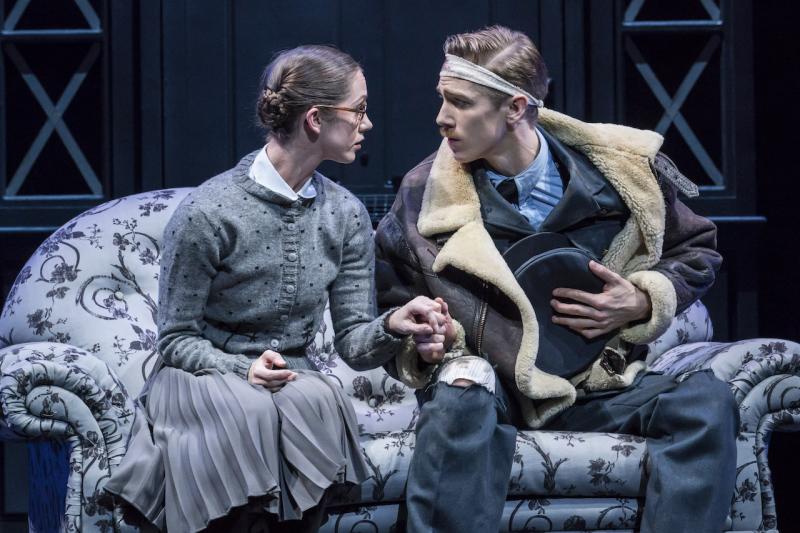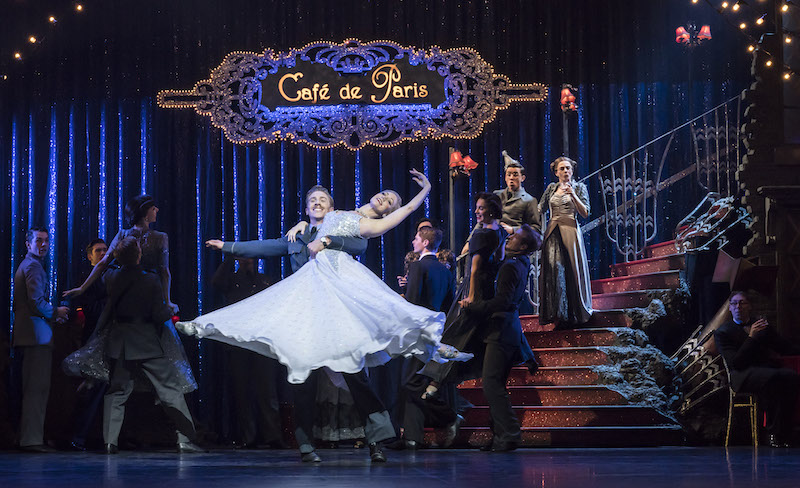Cinderella, Sadler's Wells review - Matthew Bourne puts Cinderella through the Blitz | reviews, news & interviews
Cinderella, Sadler's Wells review - Matthew Bourne puts Cinderella through the Blitz
Cinderella, Sadler's Wells review - Matthew Bourne puts Cinderella through the Blitz
Prokofiev's dark glitterball of a ballet score with added air raid sirens

Even if Matthew Bourne were never to choreograph another step, he could fill theatres in perpetuity by rotating old stock. Cinderella, made in 1997, was the follow-up to his break-out hit Swan Lake but, never quite happy with it, he reworked it in 2010, replacing the musicians in the pit with a custom-made recording of an 82-piece orchestra.
Bourne’s musical responses are key to his creativity. Connecting the tragic tug of Cinderella’s opening bars to Pathé newsreel of fire-bombed buildings in the London Blitz feels like a lightbulb moment, and the story flows from there, its romance heightened by the era’s sense of fatalism. The downtrodden heroine’s big night out is at the Café de Paris – the historic subterranean Soho dancehall that was thought to be bomb-proof until it scored a direct hit. Thus Cinders’ Prince is an off-duty RAF pilot and the realm through which he conducts his search for the girl with the missing shoe is a devastated central London in 1941. Lez Brotherston’s designs for Bourne’s shows are always a talking point, but in Cinderella he surpassed himself, evoking the sights of London in black and white and smoky greys, an extension of the Pathé newsreel style. We see St Paul’s rising above rubble, we enter an Underground station with its tarts and pickpockets. Everywhere are gap-toothed terraces, twisted railings, heaps of death. His magical coup de théâtre is to show the bombing of the Café de Paris in reverse, the destroyed venue strewn with bodies restored before our disbelieving eyes. It’s a devilish twist on that old ballet tradition, the Transformation Scene with its fairies and magic forests.
Lez Brotherston’s designs for Bourne’s shows are always a talking point, but in Cinderella he surpassed himself, evoking the sights of London in black and white and smoky greys, an extension of the Pathé newsreel style. We see St Paul’s rising above rubble, we enter an Underground station with its tarts and pickpockets. Everywhere are gap-toothed terraces, twisted railings, heaps of death. His magical coup de théâtre is to show the bombing of the Café de Paris in reverse, the destroyed venue strewn with bodies restored before our disbelieving eyes. It’s a devilish twist on that old ballet tradition, the Transformation Scene with its fairies and magic forests.
Film buffs and ballet buffs can take equal satisfaction playing the “Did you spot…?” game. Powell and Pressburger’s A Matter of Life and Death underpins the RAF theme. Cinders’ ghastly stepmother (Michaela Meazza, done up to look like Joan Crawford and also Cruella de Vil) is an obvious nod to Mommy Dearest. The Angel (Bourne’s substitute for the fairy godmother) tips a hat to Fred Astaire. The choreographic references stack up: The Red Shoes, Romeo and Juliet, Sleeping Beauty, Manon. In truth, the visual interest is so dense and multi-layered that it hardly matters that much of Bourne’s choreography is unmemorable.
It’s a blast, and the music will haunt you for days
The important thing is that it pushes the story forward, although there are moments (a long solo for Liam Mower’s camp Angel) that make you aware of an overabundance of music and not quite enough ideas to fill it. It’s to Bourne’s credit, though, that he reinstates some marvellous sections of Prokofiev in the third act that other productions habitually cut.
As in last year’s triumphant The Red Shoes, this production is blessed in Ashley Shaw (main picture, and above), a dance-actress of subtlety, power and grace who can make a drab cardigan and skirt look like Dior as she twirls around the living-room partnered by a coat-stand. Is it that Shaw makes Bourne’s choreography look better than it is, or did her talent inspire him to his best work? Perhaps both.
Elsewhere, the best dance moves are for the masses, and the final jitterbug as the curtain comes down the best of all. Bourne has always had a good eye for picking out the essence of social dances and adding his stamp. It has to be said that, narratively, some elements of this Cinderella are a little fuzzy. Premonitions and flashbacks are not always well flagged, to the extent that I was left unsure exactly when Cinders and Andrew Monaghan’s dashing airman first actually met. But given the overall dramatic thrust and visual tremendousness of this piece, it hardly matters. It’s a blast, and the music will haunt you for days.
rating
Share this article
The future of Arts Journalism
You can stop theartsdesk.com closing!
We urgently need financing to survive. Our fundraising drive has thus far raised £49,000 but we need to reach £100,000 or we will be forced to close. Please contribute here: https://gofund.me/c3f6033d
And if you can forward this information to anyone who might assist, we’d be grateful.

Subscribe to theartsdesk.com
Thank you for continuing to read our work on theartsdesk.com. For unlimited access to every article in its entirety, including our archive of more than 15,000 pieces, we're asking for £5 per month or £40 per year. We feel it's a very good deal, and hope you do too.
To take a subscription now simply click here.
And if you're looking for that extra gift for a friend or family member, why not treat them to a theartsdesk.com gift subscription?
more Dance
 'We are bowled over!' Thank you for your messages of love and support
Much-appreciated words of commendation from readers and the cultural community
'We are bowled over!' Thank you for your messages of love and support
Much-appreciated words of commendation from readers and the cultural community
 How to be a Dancer in 72,000 Easy Lessons, Teaċ Daṁsa review - a riveting account of a life in dance
Michael Keegan-Dolan's unique hybrid of physical theatre and comic monologue
How to be a Dancer in 72,000 Easy Lessons, Teaċ Daṁsa review - a riveting account of a life in dance
Michael Keegan-Dolan's unique hybrid of physical theatre and comic monologue
 A Single Man, Linbury Theatre review - an anatomy of melancholy, with breaks in the clouds
Ed Watson and Jonathan Goddard are extraordinary in Jonathan Watkins' dance theatre adaptation of Isherwood's novel
A Single Man, Linbury Theatre review - an anatomy of melancholy, with breaks in the clouds
Ed Watson and Jonathan Goddard are extraordinary in Jonathan Watkins' dance theatre adaptation of Isherwood's novel
 Peaky Blinders: The Redemption of Thomas Shelby, Rambert, Sadler's Wells review - exciting dancing, if you can see it
Six TV series reduced to 100 minutes' dance time doesn't quite compute
Peaky Blinders: The Redemption of Thomas Shelby, Rambert, Sadler's Wells review - exciting dancing, if you can see it
Six TV series reduced to 100 minutes' dance time doesn't quite compute
 Giselle, National Ballet of Japan review - return of a classic, refreshed and impeccably danced
First visit by Miyako Yoshida's company leaves you wanting more
Giselle, National Ballet of Japan review - return of a classic, refreshed and impeccably danced
First visit by Miyako Yoshida's company leaves you wanting more
 Quadrophenia, Sadler's Wells review - missed opportunity to give new stage life to a Who classic
The brilliant cast need a tighter score and a stronger narrative
Quadrophenia, Sadler's Wells review - missed opportunity to give new stage life to a Who classic
The brilliant cast need a tighter score and a stronger narrative
 The Midnight Bell, Sadler's Wells review - a first reprise for one of Matthew Bourne's most compelling shows to date
The after-hours lives of the sad and lonely are drawn with compassion, originality and skill
The Midnight Bell, Sadler's Wells review - a first reprise for one of Matthew Bourne's most compelling shows to date
The after-hours lives of the sad and lonely are drawn with compassion, originality and skill
 Ballet to Broadway: Wheeldon Works, Royal Ballet review - the impressive range and reach of Christopher Wheeldon's craft
The title says it: as dancemaker, as creative magnet, the man clearly works his socks off
Ballet to Broadway: Wheeldon Works, Royal Ballet review - the impressive range and reach of Christopher Wheeldon's craft
The title says it: as dancemaker, as creative magnet, the man clearly works his socks off
 The Forsythe Programme, English National Ballet review - brains, beauty and bravura
Once again the veteran choreographer and maverick William Forsythe raises ENB's game
The Forsythe Programme, English National Ballet review - brains, beauty and bravura
Once again the veteran choreographer and maverick William Forsythe raises ENB's game
 Sad Book, Hackney Empire review - What we feel, what we show, and the many ways we deal with sadness
A book about navigating grief feeds into unusual and compelling dance theatre
Sad Book, Hackney Empire review - What we feel, what we show, and the many ways we deal with sadness
A book about navigating grief feeds into unusual and compelling dance theatre
 Balanchine: Three Signature Works, Royal Ballet review - exuberant, joyful, exhilarating
A triumphant triple bill
Balanchine: Three Signature Works, Royal Ballet review - exuberant, joyful, exhilarating
A triumphant triple bill
 Romeo and Juliet, Royal Ballet review - Shakespeare without the words, with music to die for
Kenneth MacMillan's first and best-loved masterpiece turns 60
Romeo and Juliet, Royal Ballet review - Shakespeare without the words, with music to die for
Kenneth MacMillan's first and best-loved masterpiece turns 60

Add comment